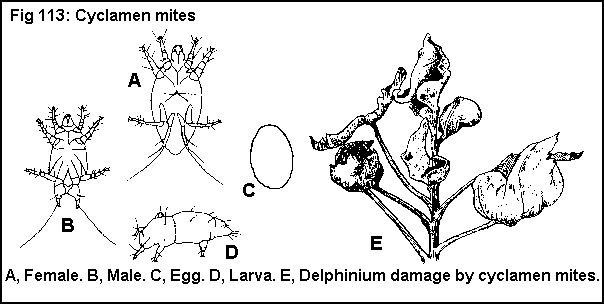Stenotarsonemus pallidus (Banks). Tarsonemidae, ACARINA

Return to: MREC Home Page
Return to: index
DESCRIPTION
Adult- These mites are tiny animals, less than 0.3 mm long. Colorless or brown tinted and waxy looking, they have four pairs of legs. The fourth pair of the female is slender with a long, hair extending from the tip. The fourth pair of legs of the males ends in a strong claw.
Egg- The elliptical egg is 0.1 mm long and smooth.
Larva- The young mites are about 0.2 mm long and are whitish and have three pairs of legs. The legs have microscopic claws and suction cups.
Quiescent Stage- This stage appears as an immobile, engorged larva.
Fig. 113: Cyclamen mite,
Stenotarsonemus pallidus (Banks). Tarsonemidae, ACARINA

A. Adult-female, B. Male, C. Egg, D. Larva. E, Delphinium damage by cyclamen mites.
BIOLOGY
Distribution- The cyclamen mite is found throughout the United States and Europe.
Host Plants- African violets are most often damaged by cyclamen mites. They also have been found on ivy, snapdragon, chrysanthemum, larkspur. geranium. fuschia, begonia, petunia, daisy, and azalea.
Damage- Cyclamen mites cause tuberous begonia and cyclamen flowers to be discolored or to shrivel or wilt. Infested flowers may not open properly or may not open at all. The mites also cause puckering, crinkling, and curling of leaves; infested leaves become brittle. Infested cyclamen buds fail to open or the flowers are distorted.
Life History- Cyclamen mites were first reported in the United States about 1900. It has since become famous as a harmful plant pest. Cyclamen mites seem to avoid the light; they occur in hidden areas on plants (on buds, and between the calyx and corolla and the stamens and ovaries of flowers). This mite also prefers high humidity. The eggs have delicate shells that can often be found collapsed among masses of unhatched eggs and mites. Deposited in moist, dark places and in small groups, the eggs require about 11 days to hatch. The mites molt only once. New larvae have wrinkled skin that stretches as they grow. They are highly active for about one week, after which they enter a quiescent stage for a few days and then molt to the adult stage. Each day the female lays two or three eggs. Eggs are relatively large in comparison to the adults. Cyclamen mites often exist wherever old cyclamen corms are preserved in the greenhouse. If a suitable host is not present year-round, female mites may semihibernate in the soil until a host becomes available. Females are usually more abundant than males in the winter months, and they live longer than males.
CONTROL
Immersing infested plants (pot and all) into water heated to 43°C for 15 minutes kills cyclamen mites without harming most plants. If chemical control is desired, spray or dip the plant thoroughly with a miticide. For specific chemical control recommendations, see the current Cooperative Extension Service publications on ornamental plant pest management or consult your county Extension agent.
University of Florida/IFAS Pest Control Guides